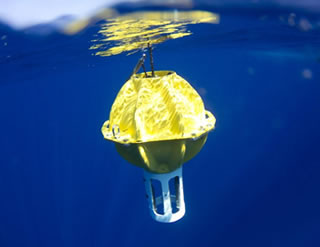Deep profile floats
There are only sparse observations of the deep ocean, yet what measurements have been made indicate that it is warming, e.g. Johnson et al. (2007), Levitus et al. (2000). The limited availability of deep ocean data is a source of major uncertainties in climate change predictions.
Before the advent of deep profiling floats, the Argo array was limited to the upper 2000 m of the ocean due to hardware restrictions: the key restriction being the lack of a small, energy efficient and reliable buoyancy engine and a high precision, low energy CTD.
Recently, several deep profile floats have been developed. JAMSTEC and TSK have developed a deep profiling float where the buoyancy engine is a hybrid of the single-stroke piston (which provides excellent buoyancy control and reliability) and the hydraulic pump (which is small in size and provides large buoyancy generation). This deep 'NINJA' float has been tested and is capable of sampling at depths of over 4000 m.

JAMSTEC Deep NINJA profiling float.
Teledyne Webb Research have also developed deep profiling floats in collaboration with Teledyne Benthos. The hull of Teledyne's APEX deep float is made from a glass sphere that can withstand over 500 cycles down to depths of 6000 metres.

Teledyne Webb Research's APEX deep float.